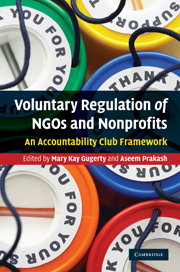Book contents
- Frontmatter
- Contents
- List of figures
- List of tables
- Notes on contributors
- Preface
- The club framework
- Part I Club emergence
- Part II Club sponsorship and club design
- Part III Club design and effectiveness
- 9 The impact of sponsorship on club standards and design
- 10 The emergence and design of NGO clubs in Africa
- 11 The benefits of accreditation clubs for fundraising nonprofits
- Future research and conclusions
- Index
- References
9 - The impact of sponsorship on club standards and design
from Part III - Club design and effectiveness
Published online by Cambridge University Press: 10 November 2010
- Frontmatter
- Contents
- List of figures
- List of tables
- Notes on contributors
- Preface
- The club framework
- Part I Club emergence
- Part II Club sponsorship and club design
- Part III Club design and effectiveness
- 9 The impact of sponsorship on club standards and design
- 10 The emergence and design of NGO clubs in Africa
- 11 The benefits of accreditation clubs for fundraising nonprofits
- Future research and conclusions
- Index
- References
Summary
This chapter examines the emergence, structure, and design of two nonprofit accountability clubs in the state of Minnesota: the Charities Review Council, one of the oldest independent third-party certification programs in the USA, and the Principles and Practices for Nonprofit Excellence program of the Minnesota Council of Nonprofits, an accountability club sponsored by a statewide umbrella association of 1,850 nonprofit organizations. A key difference between the two clubs is the identity of the sponsors: the Charities Review Council (hereafter CRC) is sponsored by an actor who represents nonprofit donors. In contrast, the Minnesota Council of Nonprofits (or MCN) operates as an accountability club sponsored by a statewide nonprofit association. The perspective outlined by Gugerty and Prakash in the introductory chapter of this volume suggests that the accountability challenges nonprofits face can be viewed as agency dilemmas between nonprofits and their stakeholders, or principals. Accountability clubs arise to send signals to key principals about the quality and trustworthiness of the nonprofits that participate (and in some instances, those nonprofits that eschew participation). But the identity of club organizers, or sponsors, and the individual club's institutional context will shape the way in which club design reflects accountability claims, even in the same geographic and nonprofit context. Using a case study approach, this chapter investigates the impact of sponsorship on the emergence, structure, and desired outcomes in two voluntary clubs in Minnesota.
- Type
- Chapter
- Information
- Voluntary Regulation of NGOs and NonprofitsAn Accountability Club Framework, pp. 203 - 227Publisher: Cambridge University PressPrint publication year: 2010



